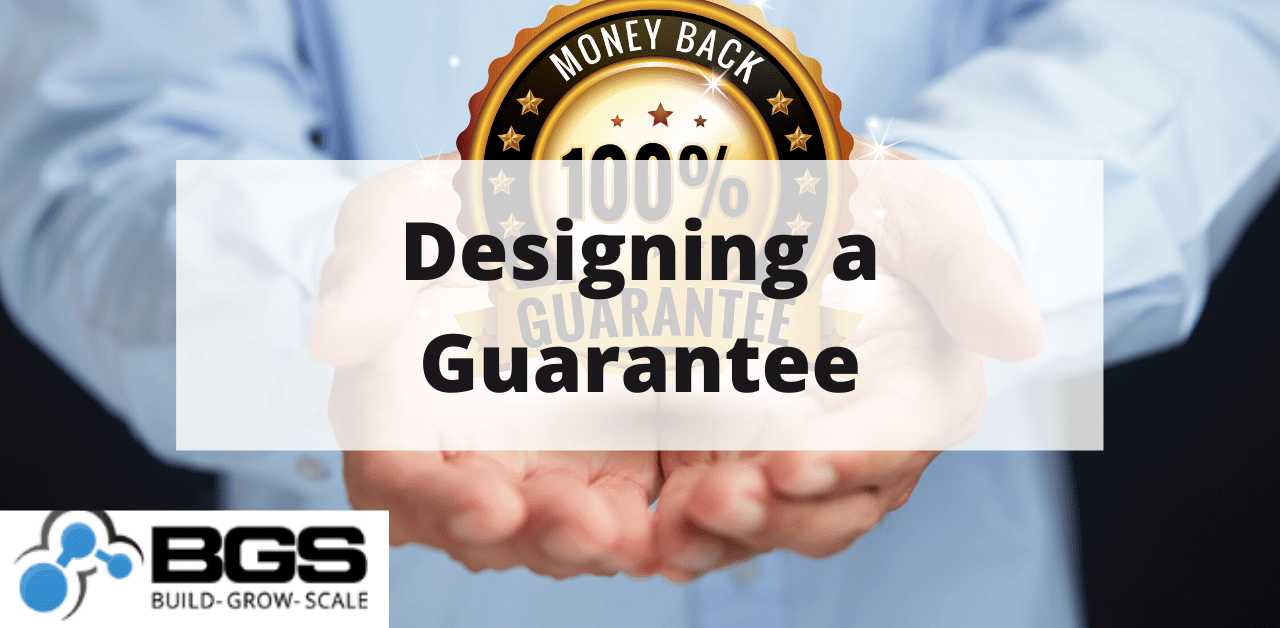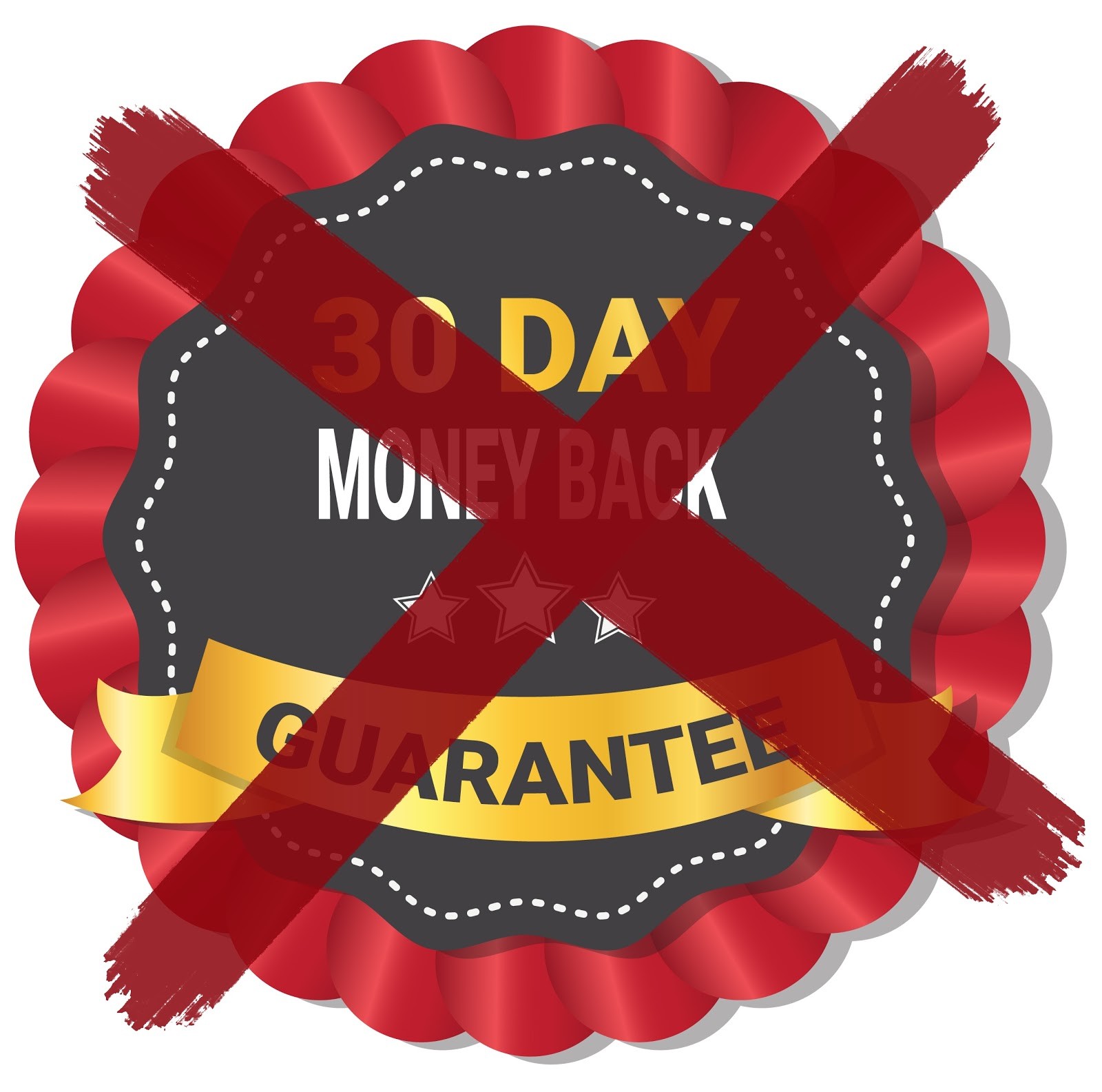Designing a Guarantee

In your customers’ eyes, there is always a risk when shopping online. Even I am skeptical when shopping on a new site!
No matter how trustworthy your business seems, there will always be people who carry fear, uncertainty, and doubt (FUDs) into their shopping experience. It only takes one negative event for your visitor to experience FUDs while online shopping.
But there are many ways we can instill trust in our visitors, and that’s what we’re going to dive into here. Each element plays their own part, and all are extremely important. Visualize each of these elements as a cog in a wheel. When all the moving parts are working correctly, we have success!
These cogs may include providing users with high-quality product images, fast and reliable customer service, captivating descriptions that call out our products features and benefits, testimonials from happy customers, accurately estimated shipping times and costs, size charts or wizards to help users find the right size or product for them, and guarantees that mitigate the risk of making a regretted purchase.
In this article, I want to take a look at one type of cog in particular—the beast of guarantees.
Creating the perfect guarantee for your business can make a significant impact on conversions and customer satisfaction. It can also help you build a great relationship with your customers.
What Type of Guarantee Should I Use?
Many businesses simply copy each other’s guarantees or use the most generic ones without knowing if these guarantees actually benefit their customers at all! Yes, I’m talking about the classic “satisfaction guarantee.”
To determine what will work best for you, you first need to understand what your customers’ FUDs are. Understanding this will allow you to craft a guarantee that speaks directly to those worries and then offers a solution that silences and overcomes these objections, making visitors much more likely to smash that “Add to Cart” button (or whatever your conversion goal may be)!
Now you may be asking yourself, “But how do I find out what my customers’ worries are?”
Well there are a few ways, but they all require communication. Surprising, right? Whether you communicate via phone calls, support emails, onsite polls, post-purchase surveys, feedback on your ads, social media pages, and so on. All of these methods will shed some light on what may be holding your customers back.
If you have a dedicated team for customer service, perfect. Reach out to your team, and ask them to let you know some of the most popular questions or complaints your customers have.
Another method—and one we continuously use and recommend—is to request post-purchase surveys. This could appear in the form as an email flow or a customer feedback tool such as Lucky Orange or Hotjar. Within these apps, you can set up surveys or pop-ups to appear on any page with certain triggers. Typically, we place these pop-ups on the thank-you page.
This is great for a couple of reasons. This request will appear right after customers make their purchase, so FUDs will be on their mind but you won’t be interrupting your customers while they’re making their way through their buyer’s journey.
Some of our biggest wins have come from directly addressing concerns that we have uncovered from this simple question in our post-purchase surveys: “What was your biggest fear or concern before buying with us?”
Give It a Try!
Once you’ve started to receive feedback from your customers, scan the replies to begin figuring out what your customers fear the most. It could be shipping times, unexpected costs at checkout, where the product is manufactured, and the list goes on.
This will give you a massive advantage when developing your value propositions and designing your guarantee. If you want to learn more about using polls to find big-money wins across your ecommerce store, see our article on the topic.
Now that you have an idea of what may be holding your customers back. You can use this powerful knowledge while developing your copywriting arsenal and constructing guarantees.
You may have thought to yourself, “Well, I’ll just add a satisfaction guarantee like everyone else does.”
Do not do this! Although a generic satisfaction guarantee is better than nothing. You can do better …
Generic 30-day money-back guarantees are so overused now in ecommerce that customers believe it’s a God-given right, not a generous perk offered to them by a company.
They don’t really scream confidence either. Thirty days isn’t a long time, and even the cheapest, most poorly manufactured products can outlast this timeframe.
So today I’d like to offer you three satisfaction guarantees that shake up the norm and, most importantly, silence those objections.
Just remember: When you’re designing your guarantee, think in terms of making it prominent on your most important pages, such as the product, cart, and checkout pages. If you have it buried somewhere (for example, on your support page), no one will see it and it won’t be very effective.
Most important is to stand by your promises. Always honor your word and be completely transparent. There is enough shadiness out there already, and the darkness will always come to light.
1. The Lifetime Guarantee
The ultimate guarantee, the be-all-end-all of guarantees, the GOAT (Greatest of All Time)—You get the point …
You are telling your customers that you believe in your product so much that you are completely taking away their fear of disappointment. Not every business can offer this guarantee, but if you can, test it!
Typically these guarantees work best for higher-priced products that will get users off the fence on deciding whether it is worth it or not. If you truly do offer a quality product, then I can almost “guarantee” you won’t see many people ask to claim this.
Here is my absolute favorite lifetime guarantee–something I came across after I began writing this article–from Saddleback Leather Co.
This company promises a 100-year warranty. They’re so confident in their craftsmanship and high-quality materials that they know they can offer a guarantee that spans longer than most lifetimes.
Here is a message on their warranty page: “If it’s our fault that it broke because of poor craftsmanship or defective materials, then we’ll fix it or replace it for free for 100 years under our Warranty. Even rocks wear away, eventually.”
In fact, they go on to prove how durable their product is by testing it on an animal that yields the strongest bite in the animal kingdom, the saltwater crocodile.
That’s brilliant marketing and a great guarantee.
2. The Lowest-Price Guarantee
If you know anything about what we preach in ecommerce, you know we teach you how to be unique and separate yourselves from your competitors. There are many ways you can achieve this. Offering the lowest price or price-matching your competitors is one of them.
Pricing is among the top three biggest reasons consumers choose one business over another. So if you can, consider offering a lowest-price guarantee.
The goal you’re trying to achieve with this guarantee is to keep your customers from scouring the internet looking for cheaper alternatives. You do this by promising them you’re offering them the best price possible.
We have seen excellent examples of lowest-price guarantees, some even going as far as offering a small discount on top of a matched price.
Here’s an example: A customer finds the same product at a competitor’s store where it’s a little cheaper than the product you’re advertising on your site. You address that within your lowest-price guarantee by stating that if a competitor has the same item available online at a lower price, you will beat it by 5%.
This option may not be viable for your business due to cheap knockoffs or similar products sold on Amazon for a far cheaper price. Your margins may be too slim already. If so, do not consider this option and focus on offering the best-quality product in your niche and work on reducing your overall costs.
Also, be careful not to start price wars. You don’t want to be slashing prices and offering big discounts as a race-to-the-bottom-price battle with your competitors. When that happens, nobody wins.
You can most definitely still be successful without having to lower your prices. I am offering this example of a guarantee because price is an extremely powerful lever and is a common objection for online shoppers across the globe.
If you can beat your competitors’ prices while remaining profitable, you are in a great position to win some of that traffic that’s looking for the best deal.
3. The Free-Trial Guarantee
Everyone knows this one! It’s especially popular with digital products and subscription services. This guarantee has been around forever and has stood the test of time!
For example, take Amazon, the leader in online sales. According to TechCrunch, they account for more than half of the ecommerce transactions in the United States.
They also offer a 30-day free trial with the opportunity to cancel anytime within that period. Their subscription offers free shipping, usually within two days, and access to popular movies and TV shows.
With a guarantee of this kind, it’s so important to nurture your customers. Help them utilize your product to the best of their ability and to ensure their satisfaction. You can do this by reaching out to your customers via post-purchase follow-up emails.
If they are happy with your product within their trial period, there’s a good chance you’ll now have one happy customer who is more than happy to recommend you to their friends and family.
There is still a lot of room to experiment with this in the physical product realm, clothing retailers being among the first to really delve into this approach. They’ve allowed customers to purchase multiple pieces of clothing and then return anything they do not like for reasons such as not fitting correctly.
I was searching for other businesses that uphold this guarantee and came across a company called Koala. They are an award-winning furniture store that specializes in mattresses. One thing I noticed and really liked is their take on the satisfaction guarantee.
They frame it as a 120-night free trial. In reality, it’s simply a satisfaction guarantee, but note the change of verbiage.
Conclusion
If you have made it this far, you’re now equipped with a wealth of practices that can help you determine your customers’ biggest objections. These practices can also provide your visitors with a guarantee that minimizes any concerns they may have before they make a purchase.
Resources
Lunden, I. (2018). Amazon’s share of the US e-commerce market Is now 49%, or 5% of all retail spend. TechCrunch.










